News
‹ back to weather news
News
-
Do not forget sunscreen and a hat even on a cloudy day.
Craig Mitchell, 17 November 2024A phrase often repeated to children before they head outdoors, "Don't forget to put on sunscreen and where is your hat!" may seem like routine advice, but it is important guidance for long-term skin health.
Repeated and excessive exposure to the sun's ultraviolet (UV) radiation not only increases the likelihood of immediate skin damage (such as sunburn) but also raises the risk of developing skin cancer over time.
Exposure to UV radiation can also cause injury to your eyes with long term damage leading to cataracts, macular degeneration and similarly skin cancer around the eyelids. Wearing proper sunglasses with UV filtering can help prevent the damaging effects.
What is Ultraviolet radiation?
 Image: Solar radiation spectrum Source - What is ultraviolet radiation? - Canada.ca https://www.canada.ca/en/health-canada/services/sun-safety/what-is-ultraviolet-radiation.html
Image: Solar radiation spectrum Source - What is ultraviolet radiation? - Canada.ca https://www.canada.ca/en/health-canada/services/sun-safety/what-is-ultraviolet-radiation.htmlThe Sun emits electromagnetic radiation, which encompasses a broad spectrum of energy. Within this spectrum, visible light falls between 380 and 720 nanometers (nm). Ultraviolet radiation (UV) falls just outside the visible spectrum, with shorter wavelengths that are not visible to the naked eye.
UV radiation is categorized into three distinct bands based on its wavelength:
UVA (Ultraviolet A):
- UVA has the longest wavelength in the UV range and can penetrate deeply into the skin, reaching the dermis (the skin's deeper layer).
- It plays a significant role in premature skin aging (photoaging) and is associated with the development of skin cancers, including melanoma. UVA is responsible for 95% of UV radiation reaching the Earth's surface and contributes to the cumulative risk of skin damage over time.
UVB (Ultraviolet B):
- UVB rays are more energetic and are a shorter wavelength than UVA rays. They primarily affect the outermost layer of skin (the epidermis).
- UVB is the primary cause of sunburn and is closely linked to the development of most skin cancers, including basal cell carcinoma (BCC), squamous cell carcinoma (SCC), and melanoma. Although UVB radiation makes up a smaller portion of the UV radiation reaching the Earth's surface (approximately 5%), it is far more biologically active than UVA.
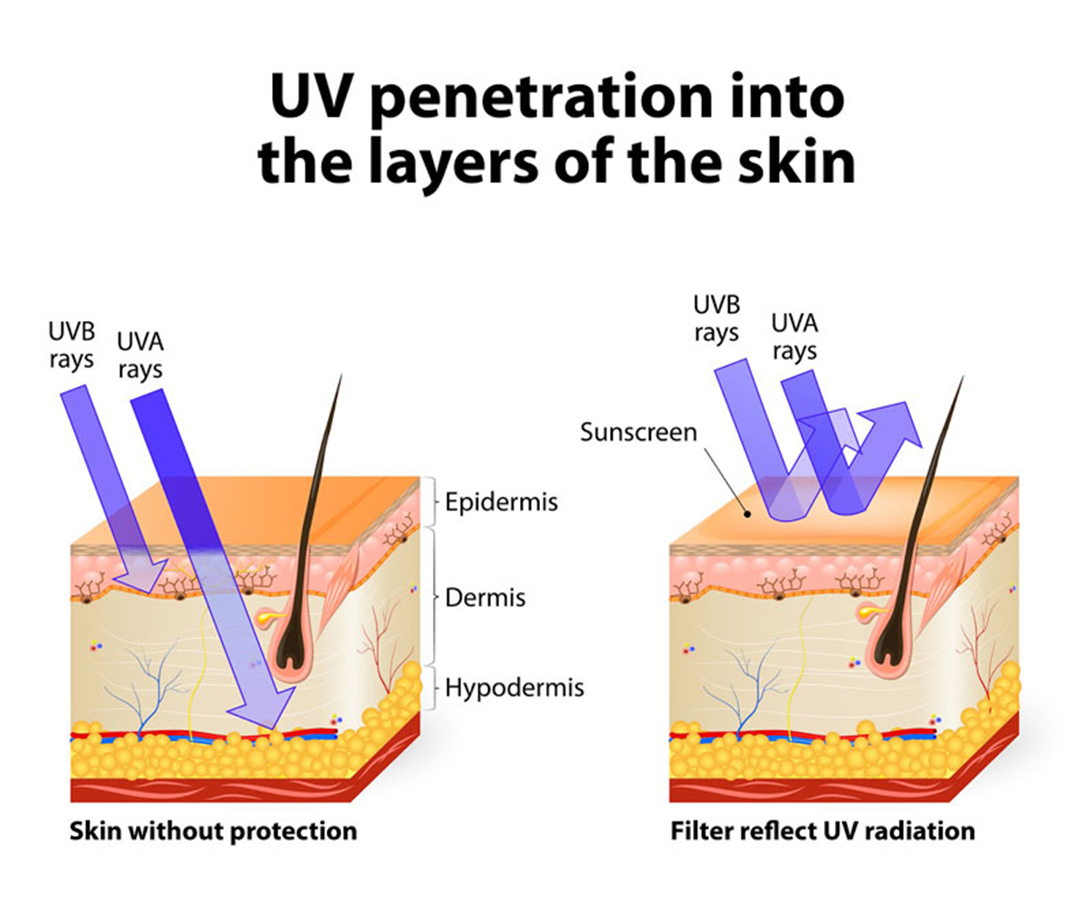
Image: UVA and UVB effects on the skin with no sunscreen (left image) and with application of sunscreen (right image) Source https://www.aimatmelanoma.org/melanoma-101/prevention/what-is-ultraviolet-uv-radiation/
UVC (Ultraviolet C):
- UVC is the most dangerous form of UV radiation, but it is largely absorbed by the Earth's ozone layer and does not reach the surface.
A common misconception is that cloud cover offers complete protection from UV radiation, leading many people to forego sunscreen or protective clothing when the sky is generally cloudy or overcast. However, this assumption is misleading, and individuals are still at risk of significant UV exposure on cloudy days.
UV Penetration Through Clouds:
Thick clouds and overcast skies can block a large portion of UV radiation, although some UVA and UVB radiation still reaches the Earth's surface. The reduction in UV exposure depends on the density and thickness of the clouds.
In fully overcast skies, UV radiation can be reduced by approximately 70–90%.
Over 90% of UV radiation can penetrate through thin, wispy clouds, which offer minimal protection. Even on days with scattered or light cloud cover, the UV radiation reaching the surface may still be substantial.
On partly cloudy days, UV radiation can scatter off the edges of cumulus clouds, creating a "randomised" effect. As a result, individuals can experience short-term bursts of UV radiation that may be HIGHER than on a clear, cloud-free day. The combination of direct UV exposure from breaks in the clouds and scattered UV radiation from nearby clouds can lead to higher levels of UV exposure, which may increase the risk of sunburn or skin damage.
Another important aspect is UV reflection from surfaces:
UV radiation can also be reflected off surfaces such as water, sand, snow, or even concrete. This reflection increases the overall UV exposure, even in the absence of direct sunlight. This effect is especially important for activities near reflective surfaces, such as at the beach, by a pool, or in the snow.
Skin type and exposure to UV radiation
Not all skin types react to UV exposure in the same way. The amount of melanin in the skin determines the skin type with low melanin levels providing fair skin color (type 1) and high levels darker skin color (type 6). Melanin also provides some natural protection from UV radiation. People with Type 1 skin will burn easily and are at greatest risk of skin cancer while Type 6 skin burns less easily and the risk of skin cancer is relatively low.
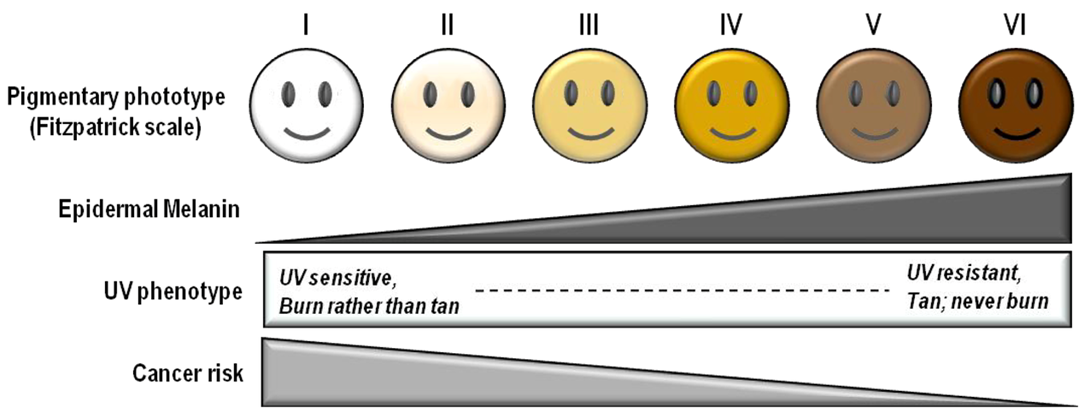
Image: By John D'Orazio, Stuart Jarrett, Alexandra Amaro-Ortiz and Timothy Scott - John D'Orazio et al. "UV Radiation and the Skin" Int. J. Mol. Sci. 2013, 14(6), 12222-12248; doi:10.3390/ijms140612222 http://www.mdpi.com/1422-0067/14/6/12222/htm, CC BY 3.0, https://commons.wikimedia.org/w/index.php?curid=49672997
Real-time Ultraviolet radiation levels can be monitored through the Australian Radiation Protection and Nuclear Safety Agency (ARPANSA) and the following website
Ultraviolet radiation index | ARPANSA
The variation in the amount of UV radiation reaching the earth's surface through differing cloud states are shown in the following images recorded on Saturday 16th November.
Total overcast cloud cover observed at Sydney
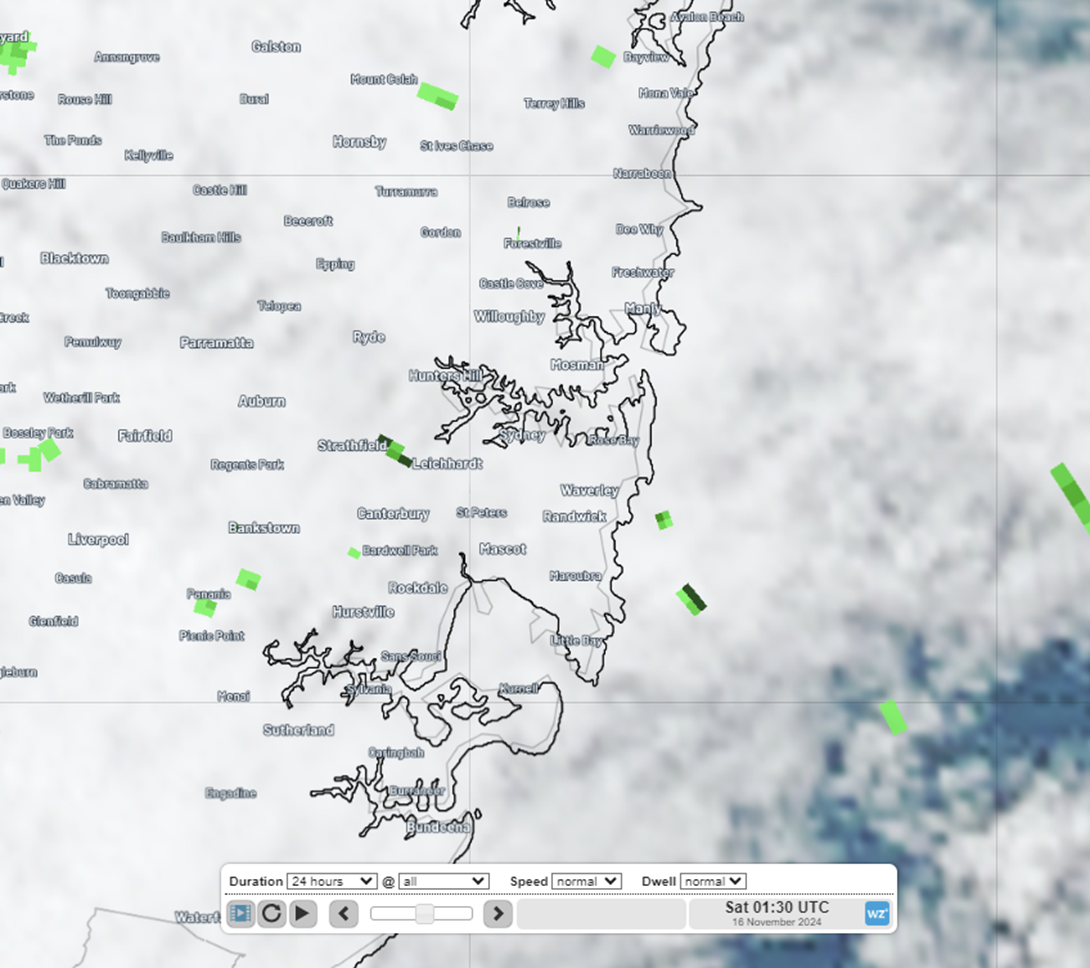
Image: Visible satellite at 2:30pm ADST on Saturday 16th November. Total overcast cloud cover across the broader Sydney region.

Image: Webcam image looking southeast from Potts Point, Sydney across the city of Sydney at 12:42pm ADST. Overcast skies with medium cloud thickness and total obscuration of the sun (credit: Potts Point, NSW, Australia - Sydney Web Cam)
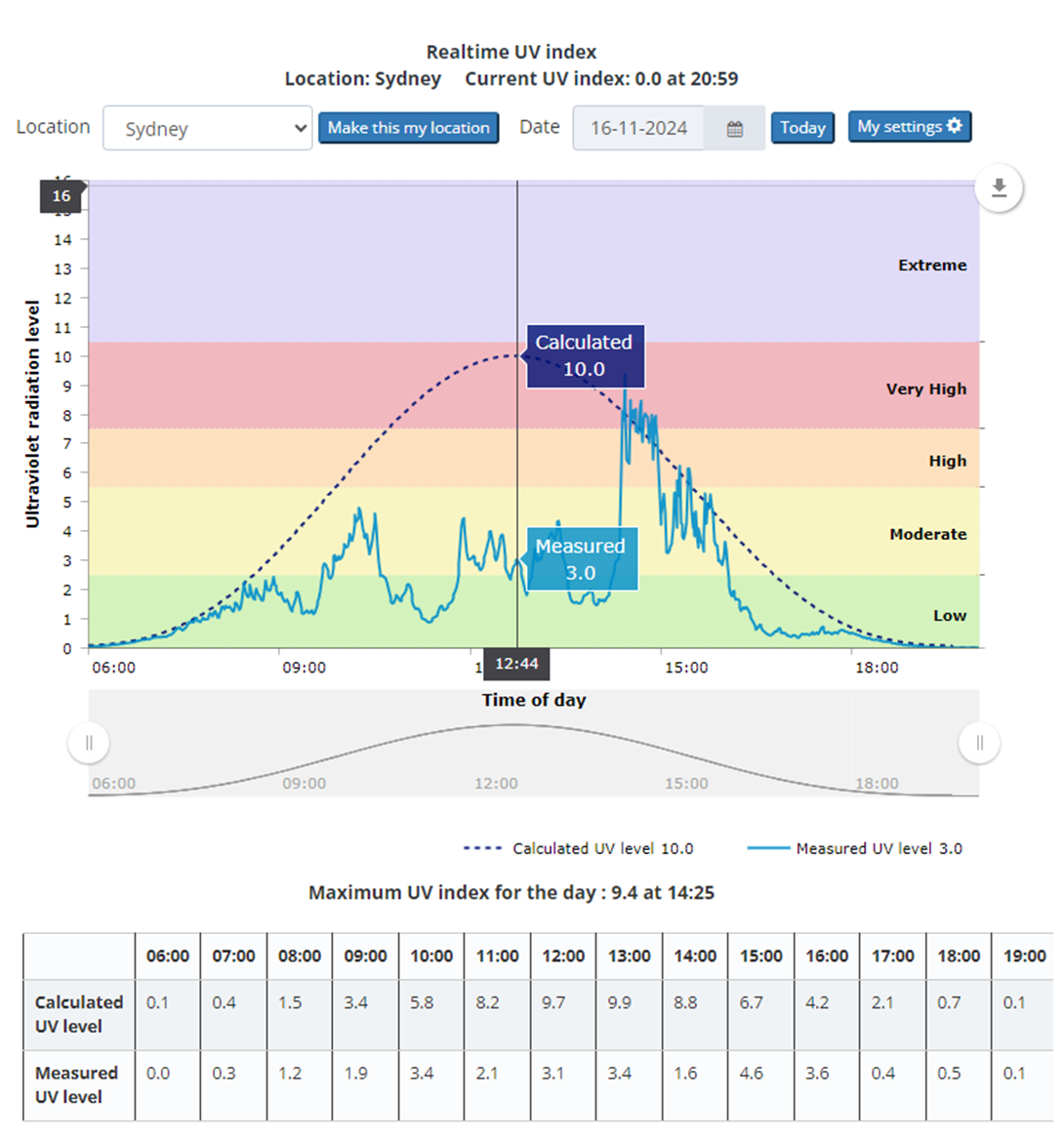
Image: Recorded UV radiation for Sydney from ARPANSA. UV levels at 2:25pm ADST measured at 3.0 and MODERATE UV rating.
Estimated time of exposure before the appearance of first degree burns for Sydney at 2:25pm ADST:
(sunburn times are taken from: A guide for publication and interpretation of solar UV Index forecasts for the public prepared by the Working Group 4 of the COST-713 Action "UVB Forecasting", Brussels, 1999)
Skin type
Measured UV rating: 3.0
Type 1 – light, pale skin
40 min
Type 2 – white, fair skin
60 min
Type 3 – Medium, white to olive skin
80 min
Type 4 – Olive, moderate brown skin
100 min
High, thin cloud cover at Darwin
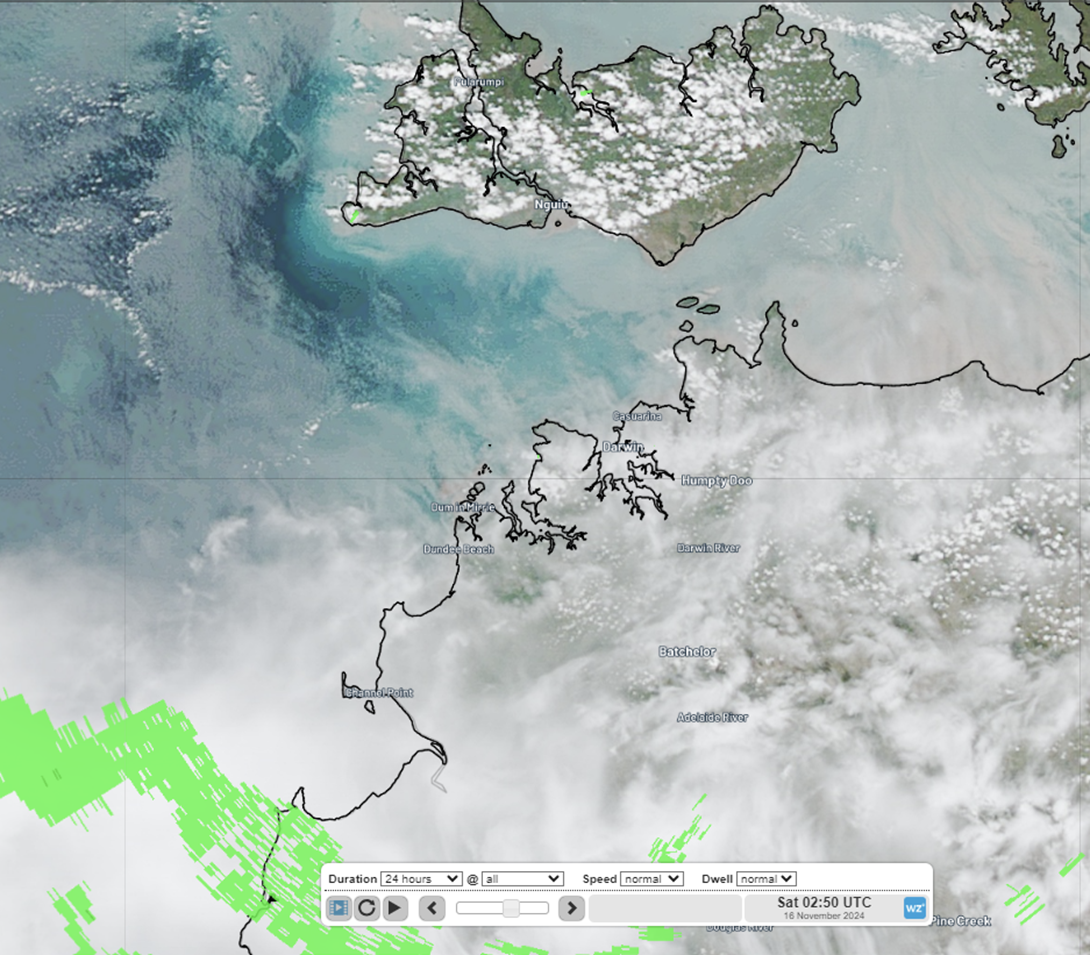
Image: Visible satellite image at Darwin for 12:20pm ACST
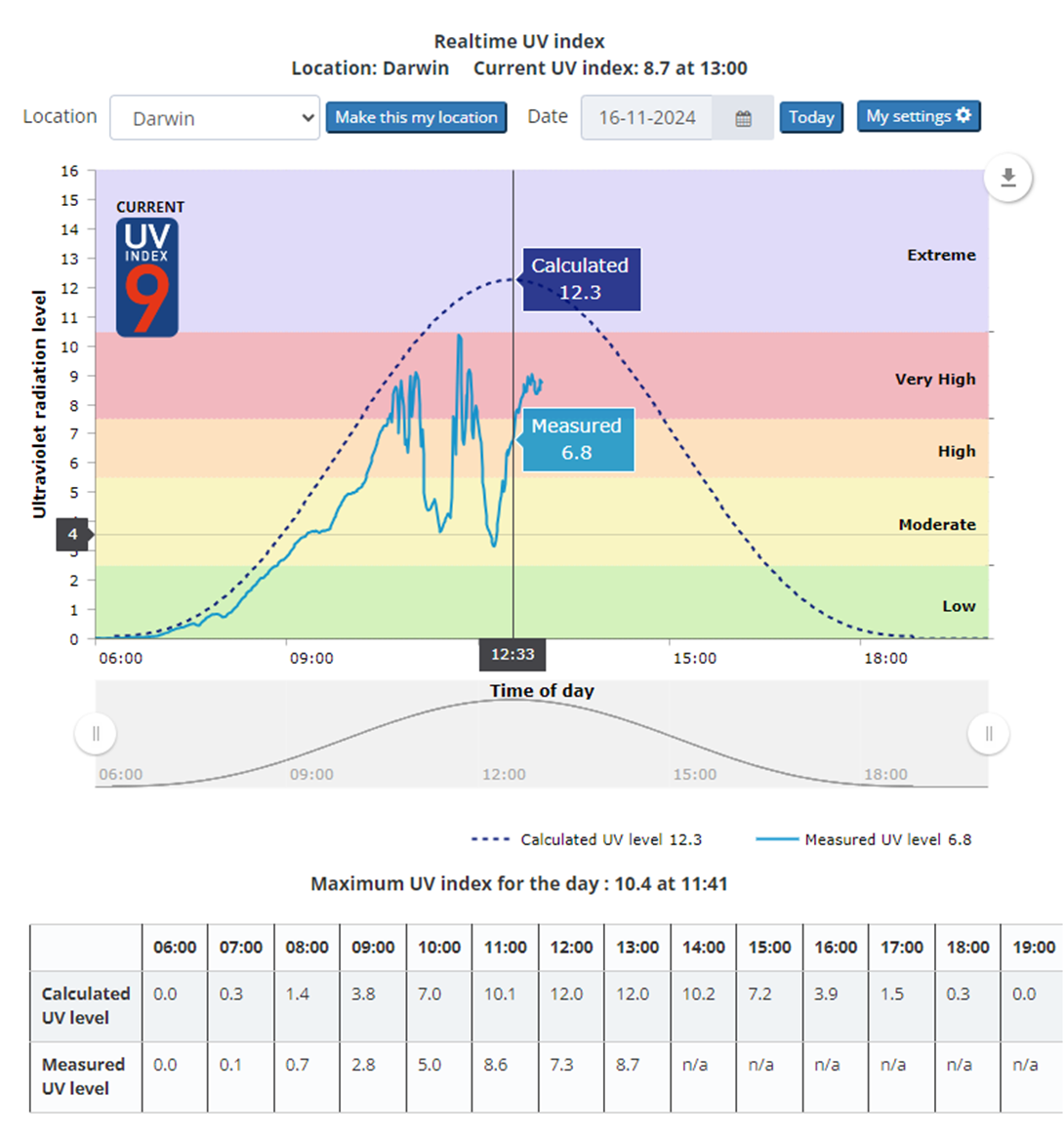
Image: Recorded UV radiation for Darwin from ARPANSA. UV levels at 12:33pm ACST measured at 6.8 and HIGH UV rating.
Estimated time of exposure before the appearance of first degree burns for Darwin at 12:33pm ACST:
Skin type
Measured UV rating: 6.8
Type 1 – light, pale skin
19 min
Type 2 – white, fair skin
24 min
Type 3 – Medium, white to olive skin
35 min
Type 4 – Olive, moderate brown skin
40 min
Whether you go outside on a sunny or cloudy day, consider practicing sensible sun safety measures:
- Slip on protective clothing that covers as much skin area as possible
- Slop on sun protection factor cream (SPF) with a rating of SPF50 or SFP50+ and cover areas of skin exposed to sunlight
- Slap of a hat with a preferable broad brim and made of closely woven fabric
- Seek shad where possible
- And Slide on sunglasses with a Eye Protection Factor (EPF) of 9 or above.
Remember, BE SUN SMART this summer.
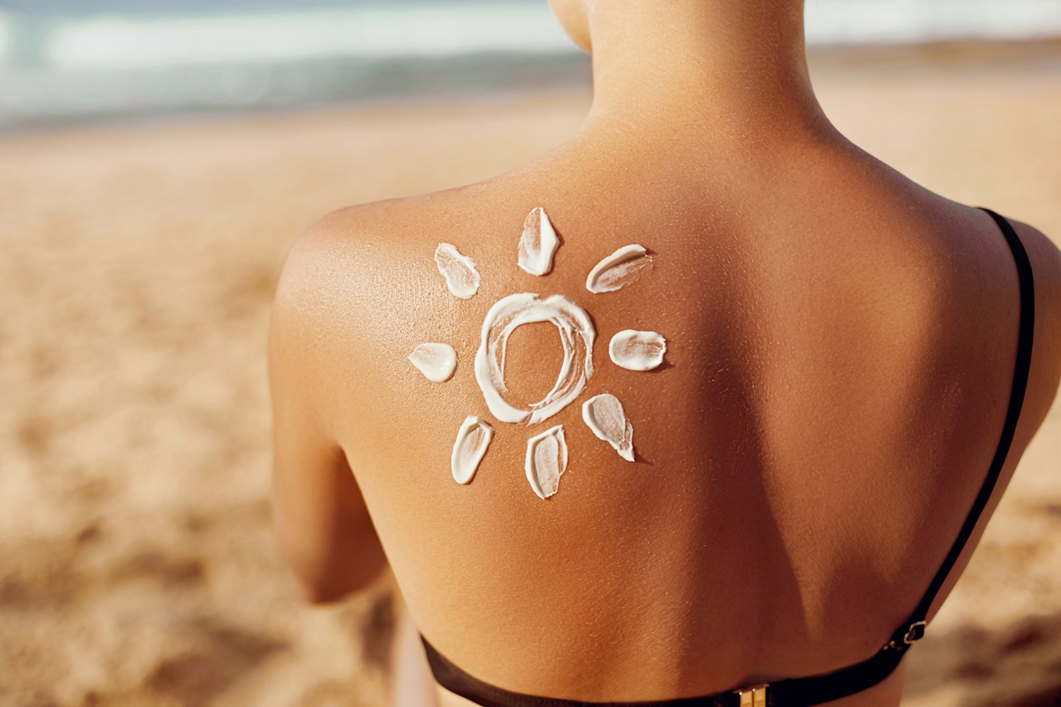
Lead image: iStock: credit - nemchinowa
- Other news
- Mon 25 Nov 2024 Severe heatwave takes hold of NSW
- Mon 25 Nov 2024 Heaviest rain in almost three years in Victorian city
- Mon 25 Nov 2024 Big stormy end to spring looms for Australia
- Sun 24 Nov 2024 Nature’s air conditioner: how the seabreeze will help Sydney cope during the heatwave
- Sat 23 Nov 2024 Ever Wondered Why It Takes Longer to Fly from Brisbane to Perth Than the Other Way? Here’s the Surprising Reason!

